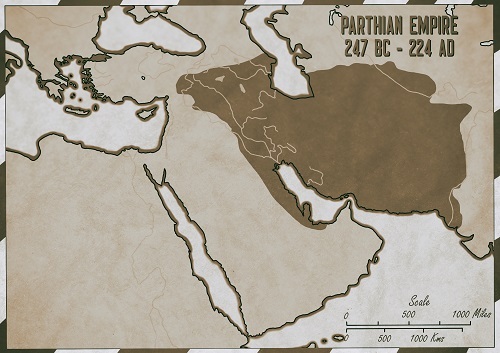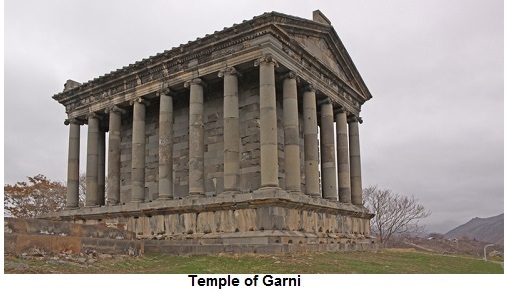

 From 12 to 428, the Arsacid dynasty, also known as the Arshakuni, represented the Armenian Dynasty. The daimyo was a branch of the Arsacid dynasty based in Parthia. During the turbulent years that followed the Artaxiad dynasty's demise, Arsacid kings presided briefly until Tiridates I, the brother of Parthian king Vologases I, established Arsacid power in Armenia as a customer king of Rome. The conversion of Armenia to Christianity with the assistance of Gregory, Tiridates III, and the Illuminator, and the introduction of Armenian notation by Mesrop Mashtots in around 405 are two of Armenia's most significant events that occurred during the Arsacid reign.
From 12 to 428, the Arsacid dynasty, also known as the Arshakuni, represented the Armenian Dynasty. The daimyo was a branch of the Arsacid dynasty based in Parthia. During the turbulent years that followed the Artaxiad dynasty's demise, Arsacid kings presided briefly until Tiridates I, the brother of Parthian king Vologases I, established Arsacid power in Armenia as a customer king of Rome. The conversion of Armenia to Christianity with the assistance of Gregory, Tiridates III, and the Illuminator, and the introduction of Armenian notation by Mesrop Mashtots in around 405 are two of Armenia's most significant events that occurred during the Arsacid reign.
The Parthian imperial Vonones I was booted out of Parthia in 12 as a corollary of his pro-Roman initiatives and Imperial actions. This constituted the first time an Arsacid occupied the throne of Armenia. Artabanus II positioned his son Orodes upon that Armenian throne succeeding Vonones I's withdrawal. Emperor Tiberius delivered his nephew and heir Germanicus toward the East as he had no ambition of relying on his belief in the Eastern perimeter buffer kingdoms.  The Romans confirmed him as their friend and dynasty in a pact that Germanicus approved with Artabanus II. Again, after a decade of peace, Tiberius expediently enhanced his combat saturation on the Roman horizon, and for the subsequent 25 years, Armenia would operate as the incident of a vicious rivalry between the two most global powers in history.
The Romans confirmed him as their friend and dynasty in a pact that Germanicus approved with Artabanus II. Again, after a decade of peace, Tiberius expediently enhanced his combat saturation on the Roman horizon, and for the subsequent 25 years, Armenia would operate as the incident of a vicious rivalry between the two most global powers in history.
Nero, the reigned, summoned General Gnaeus Domitius Corbulo with substantial coercion to the east to assign Roman client kings because he had been disappointed with the evolving Parthian primacy at their doorstep. Tigranes VI, a client king of the Romans who prospered Tiridates I after his getaway, captured the Kingdom of Adiabene, one of several Parthian colonial possessions, in 61. Reminding Trajan that Axidares had been ruined and contacting Axidares' older brother, Parthamasiris, to be issued the crown, elites from Osroes I matched Trajan in Athens.
Their handover caused Vologases IV's guidance of the Artaxata army to Roman general Priscus, who also dethroned a certain Pacorus organized by Vologases III and installed a Roman puppet, Sohaemus, upon this Armenian monarch.
Tiridates II attempted to develop courteous ties with Rome to maintain the neutrality of the Arsacid monarchy in Armenia. This had been a terrible mistake because Shapur I, the Sassanid leader, overcame the Romans and then made an alliance with Philip. Shapur I penetrated Armenia in 252, pushing Tiridates II out of his country. After Tiridates II and Khosrov II passed away, Shapur I enthroned Hurmazd as emperor of Armenia. Hurmazd acquired the Persian empire on such death of Shapur I in 270, and then Narseh commanded Armenia in his place.
King Tiridates III and his monarchs were brought to Christianity by Saint Gregory. As a virtue of Saint Mesrop Mashtots' construction of the Armenian character in 405 AD for Writings and Christianization, this period also functions as the foundation of Armenian literature. Movses Khorenatsi alleged that around 411, Isaac of Armenia converted the Gospel from said Syriac original. Two students of Mashtots, Joseph of Baghin and John of Egheghiatz were summoned to Edessa to edit the Bible early after this job must have been recognized as sufficient.
Armenia again became a matter of dispute until the final agreement was signed among the Byzantine and Sassanid Monarchies in 387. This situation persisted until the Arabs conquered Armenia in 639. Ti ll around 428, Arsacid kings infrequently continued their position of the throne as frontier keepers, under either Byzantine or a Sassanian colony.
The dynasty hit a peak after an Arsacid group was developed in this Armenian realm in the centre of the first century AD, having started with the development of the Parthians during the second century BC. Various facets of Parthian civilisation, like the gusan, who mirrored a ranger or minstrel, were explicitly assimilated into the Armenian community. The Armenians got obsessed with several of the fiction which were finally incorporated further into the Persian epic Shahnameh during the dynasty of the Arsacids. Memories of individual people like Hraseak, Sawarsh, and Spandarat are included. The Armenians thought that the connection between their nation and the Parthia's noble houses was unassailable.
The king's features of the Arsacids and the institute of the devotion of Aramazd had both been in the town of Ani. The Arsacids assembled fantastic value on the old Bagawan shrine, where they applauded Nowruz, the Iranian New Year's carnival. The Arsacids had been symbolised by the boar.
Here is some name of Armenian dynasties which succeeded from 12 and 428, the vast bulk of whom owned the Arsacid Empire. The list also provides documentation on Armenia's non-dynastic dynasties and interregnums. They are like Vonones I, Artaxias III, Arsaces I of Armenia, Mithridates of Armenia etc.
The Arsacid Monarchy, also known as the Arshakuni Dynasty, ruled the Kingdom of Armenia from 54 to 428. They began as a division of the Parthian Arsacids but gradually evolved into a purely Armenian dynasty. Both the Roman and Parthian Empires fought over the throne of Armenia, which they shared. Following the fall of the Artaxiad Dynasty, Arsacid Kings presided in an inconsequential manner until Tiridates I of Armenia established Arsacid dominion in Armenia in 62.
Q1. When did the Parthians land in India?
Ans. Gondophares constructed the Indo-Parthian Empire, a Parthian monarchy which lasted from 19 CE to approximately 226 CE. They governed more than a territory that also included portions of the eastern part of Iran, different areas of Afghanistan, as well as the northwestern area of the Indian peninsula throughout its height.
Q2. Did Rome ever prevail over the Parthians?
Ans. No. When Rome seized Greece and became acquainted with the greeks, the Empire of Achaemenid arose and collapsed. Alexander the Great collapsed the Achaemenid Empire during the delayed fourth century BC.
Q3. Who was considered the renowned Parthian king of that time?
Ans. Arsaces I, who ruled from approximately 250 BC to approximately 211 BC, established the Parthian empire. Arsaces I was an administrator for Diodotus, the Bactrian Greek monarch until he rebelled and moved to the west to consolidate his power.